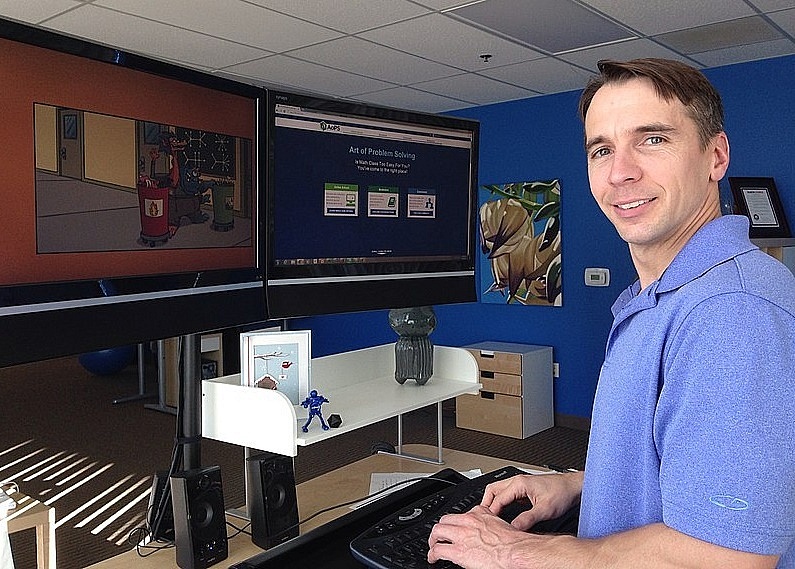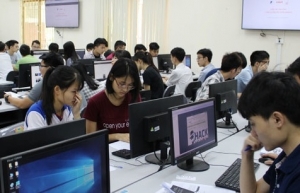Gateway to innovation proves key in development of STEM
What is currently the greatest challenge in the teaching and learning of mathematics in the United States?
In most middle schools and high schools, except for when there’s a very exceptional teacher, the teaching is quite robotic. Students are presented with how the problem works and how to solve it and are asked to do 30 copies of the problem. They eventually get through school by memorisation.
However, in college, as we try to develop future practitioners who will be creating new knowledge, students usually face difficulties when the problems on the tests don’t look like the ones they have been taught.
 |
| Richard Rusczyk, founder of AoPS, Source: Wikipedia |
The US has a so-so performance in international testing but is routinely among the strongest countries in the International Math Olympiad. Why the difference?
Over the last two decades, there have been a lot more new opportunities that are specifically designed to inspire and train eager maths students. Almost all of these opportunities are outside the school system, including summer camps, online schools, books, and many other resources, so that math-oriented students are not just relying on learning in the classroom.
Through these specialised programmes, you can draw out high-level students and bring them together. I think this has been the main development over the last 20 years in the US - what some people call “the privatisation of gifted education.”
As special programmes for kids who excel in maths have been cut in most public schools, plenty of private programmes have popped up to provide similar or even more advanced services.
The success of these programmes points to a pathway for broader improvement. Schools can draw from the tactics and strategies used in these programmes and apply them in public education, making these approaches and tools available to a much wider range of students.
I believe the same goes for Vietnam, where only children from affluent families are getting access to certain resources. There are still plenty of fantastic students out there without the means, and the system needs to be able to catch them and inspire them in the same way.
Vietnamese students regularly do well in theory-based contests, but are weak in application. How could this affect STEM development?
It’s crucial that students know how to take the core problem-solving strategies they’ve developed and apply them elsewhere, whether physics, chemistry, writing, or other fields.
For educators, it’s important to set a bar instead of creating a pyramid where the learning process becomes an arms race. To get high enough in that pyramid, students must participate beyond where it’s good for them. At 15 or 16, students should be free to explore their interests, like writing code, learning statistics, or researching machine learning and AI.
This freedom also allows them to build practical skills like developing a plan, finding the discipline to stay with it, working with a team, etc. In reality, innovative inventions usually come from combining ideas from different fields. Hence, a gateway to innovation is through time and exposing kids to many different ideas.
How does a developing country like Vietnam refine its teaching process, especially in the context of the booming Industry 4.0?
One thing that can be done is to design incentive systems for teachers. In the US, most public school teachers are evaluated based on the number of students who pass the state test, which is quite basic. The teachers then only care about kids below the bar and tend to ignore kids who are doing fine above the bar.
The same issue applies to many countries. Instead, you would want to design a system where teachers are evaluated on student growth, wherever the student is on the spectrum.
Another improvement can be with teacher training, where teachers are equipped with the tools and strategies to identify different levels of students and provide them with exactly what they need. In a public school class of about 40-50 kids, if the teacher stands at the board and lectures, they will just be in the right spot for about seven of those students. And that’s a difficult space to navigate.
This is where technology can come in to assist, so teachers can have a better understanding of each individual student and better cater to them specifically.
 | Education institutions ramp up digital infrastructure The race amongst Vietnamese universities to go digital is expected to accelerate, with schools boasting more digital components predicted to gain the upper hand in both teaching quality and admissions. |
 | New Zealand provides scholarships for Vietnamese teachers Following the success of previous years, Education New Zealand will continue to offer 30 fully-funded scholarships for Vietnamese teachers to undertake the New Zealand Global Competence Certificate (NZGCC) course. |
What the stars mean:
★ Poor ★ ★ Promising ★★★ Good ★★★★ Very good ★★★★★ Exceptional
Themes: Digital Transformation
Related Contents
Latest News
More News
- Legal framework completed for national digital transformation (December 13, 2025 | 21:55)
- How smart infrastructure and digitalisation power the systemic transition (December 11, 2025 | 10:00)
- Lawmakers split over VAT on fertilisers and animal feed (December 10, 2025 | 18:56)
- Kim Long deal marks turning point for Vietnam’s auto industry (December 10, 2025 | 18:44)
- Pernod Ricard Vietnam supports flood-hit localities (December 10, 2025 | 14:18)
- SABECO honoured at Vietnam M&A Forum for outstanding deal of 2024-2025 (December 10, 2025 | 12:00)
- Vietnam raises taxable revenue threshold for household businesses to VND500 million (December 10, 2025 | 11:34)
- Vietnam M&A Forum 2025: new position, new momentum (December 09, 2025 | 14:30)
- Masan Consumer reveals HSX listing roadmap (December 09, 2025 | 14:09)
- Industrial sector posts robust gains as year-end demand rises (December 09, 2025 | 13:38)

 Tag:
Tag:





















 Mobile Version
Mobile Version